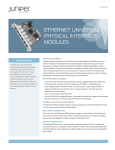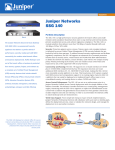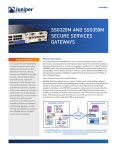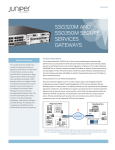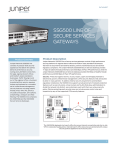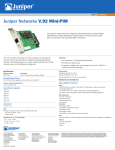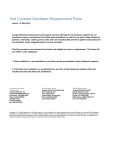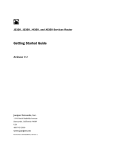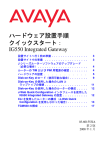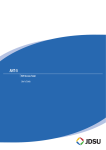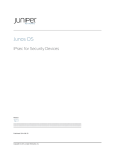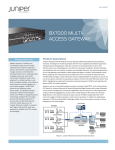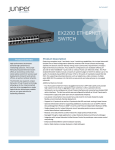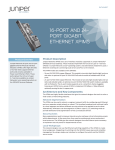Download Juniper JX-2T1-RJ48-S
Transcript
DATASHEET DUAL-PORT T1/E1 PHYSICAL INTERFACE MODULE Product Overview Dual-port T/E1 Physical Interface Module (PIM) are for use with the Juniper Networks J2320, J2350, J4350, and J6350 Services Routers, as well as the Juniper Networks SSG140, Product Description The Juniper Networks Dual-port T1/E1 PIM provides the physical connection to T1 or E1 network media types, receiving incoming packets from the network and transmitting outgoing packets to the network. The Dual-port T1/E1 PIM is equipped with a dedicated network processor that forwards incoming data packets to the Routing Engine, and receives outgoing data packets from the Routing Engine. During this process, the PIM performs T1 or E1 framing and line-speed signaling. SSG320M, SSG350M, SSG520M and When a Dual-port T1/E1 PIM is installed in a Juniper Networks® SSG Series Secure Services SSG550M Secure Services Gateways. Gateway running ScreenOS® Software, the dedicated network processor will forward traffic to the SSG Series CPU where traffic decisions are made based upon security policies. Features and Benefits Dual-port T1/E1 PIM provides the following benefits: • Dual-port form factor allows for increased bandwidth capabilities while making effective use of the J Series and SSG Series modular interface slots. • Integrated channel service unit/data service unit (CSU/DSU) eliminates the need to deploy a separate external device, saving valuable space and simplifying management. Features • Fully integrated CSU/DSU • Full and fractional T1/E1 capabilities • Onboard network processor • 56K and 64K modes support • ANSI T1.102, T1.107, T1.403 T1 support • G.703, G.704, and G.706 E1 support • Independent clock • Loopback, bit error rate test (BERT), facilities data link (FDL) (T1 only), 1 Diagnostics and long build-out diagnostics Specifications Loopbacks Product Specifications • Local, remote, payload Test Patterns (BERT) Dimensions and Weight (W x H x D) • All ones • 5.45 x 0.63 x 6.5 in (13.8 x 1.6 x 16.5 cm) • All zeros Network Interface Specifications • Alternating ones and zeros (AA/55) DUAL-PORT T1 DUAL-PORT E1 Transmit bit rate 1.544 Mbps 2.048 Mbps Receive bit rate 1.544 Mbps 2.048 Mbps Line encoding - Alternate mark inversion (AMI) - HDB3 - Bipolar with 8-zero substitution (B8ZS) - Unframed clear channel - Framed clear channel - Framed fractional - Framed clear channel - Fractional Framing • 1:3 or 1 in 4 pattern • 1:7 or 1 in 8 pattern • 3:24 - 3 bits set in every 24 bits • QRSS20 (modified PRBS 2^20-1, with 14 zero suppression) • PRBS 2^7-1 • PRBS 2^9-1 (as specified in ITU-T O.153) • PRBS 2^11-1 (as specified in ITU-T O.153)/2047 pattern - Superframe (D4/SF) - G704 • PRBS 2^15-1 (as specified in ITU-T O.151/O.153) -E xtended superframe (ESF) - G704 without CRC4 • PRBS 2^20-1 (as specified in ITU-T O.153) - Unframed • Programmable word or 32-bit programmable pattern Data Interface Network Alarms • Clocking Modes: DCE, internal, loop • Alarm indication signal (AIS) • Clocking Rates: 1.2 KHz, 2.4 KHz, 9.6 KHz, 19.2 KHz, • Loss of frame (LOF) 38.4 KHz, 56 KHz, 64 KHz, 72 KHz, 125 KHz, • Loss of signal (LOS) 148 KHz, 250 KHz, 500 KHz, 800 KHz, 1 MHz, • Yellow (YLW) 1.3 MHz, 2 MHz, 4 MHz, 8 MHz Error Counters High-Level Data Link Control (HDLC) Features • Controlled slipped seconds (CSS or CS) • N x 64 Kbps or N x 56 Kbps, non-channelized data rates • Line errored seconds (LES) (T1:N=1 to 24; E1:n=1 to 31) • Errored seconds (ES) • Cyclic redundancy check (CRC) 16/32 • Bursty errored seconds (BES) • Shared flag • Severely errored seconds (SES) • Idle flag/fill • Severely errored framing seconds (SEFS) • Counters: runts, giants, frame check sequence (FCS) error, • LOS seconds abort error, align error • LOF seconds (LOFS) Interface Connector • Unavailable seconds (UAS) • RJ-48 LEDs System Timing PIM LEDs indicate port status with the following LED states: • Internal (system clock) • External (network recovered clocks) Environmental • Operating temperature: 0° to 40° C • Storage temperature: -40° to 70° C • Relative humidity: 5% to 90% noncondensing 2 Color State Description Green On steadily Online with no alarms or failures. Red On steadily Active with a local alarm; router has detected a failure. Standards and Compliance Juniper Networks Services and Support Safety Juniper Networks is the leader in performance-enabling services • CAN/CSA-C22.2 No. 60950/UL 60950 Third Edition, Safety of Information Technology Equipment • EN 60950 (2000) Third Edition, Safety of Information Technology Equipment EMC (Emissions) • FCC Part 15 Class B • EN 55022 Class B that are designed to accelerate, extend, and optimize your high-performance network. Our services allow you to maximize operational efficiency while reducing costs and minimizing risk, achieving a faster time to value for your network. Juniper Networks ensures operational excellence by optimizing the network to maintain required levels of performance, reliability, and availability. For more details, please visit www.juniper.net/us/en/ products-services/. • AS/NZS 3548 Class B • VCCI Class B Ordering Information Immunity MODEL NUMBER DESCRIPTION • EN-61000-4-2 ESD JX-2T1-RJ48-S Dual-port T1 PIM • EN-61000-4-3 Radiated Immunity JX-2E1-RJ48-S Dual-port E1 PIM • EN-61000-4-4 EFT • EN-61000-4-5 Surge • EN-61000-4-6 Low Frequency Common Immunity European Telecommunications Standardization Institute (ETSI) • ETSI EN-300386-2: Telecommunication Network Equipment Electromagnetic Compatibility Juniper Networks Junos® Operating System Release Dual-port T1/E1 PIMs are supported on Juniper Networks J Series routers in Junos OS 7.0 and higher releases. Juniper Networks ScreenOS Software Release The Dual-port T1/E1 PIM is supported in ScreenOS 5.1 and Telecom higher releases on the SSG500 line, ScreenOS 6.0/r2 and higher • FCC Part 68/TIA-968 releases on the SSG300 line, and ScreenOS 5.4 and higher • IC CS-03 T1 Standards • ANSI T1.102 • ANSI T1.107 • ANSI T1.403 • Telcordia GR-499-CORE • ACCUNET TR 62411 (Accunet T1.5) E1 Standards releases on the SSG140. About Juniper Networks Juniper Networks is in the business of network innovation. From devices to data centers, from consumers to cloud providers, Juniper Networks delivers the software, silicon and systems that transform the experience and economics of networking. The company serves customers and partners worldwide. Additional information can be found at www.juniper.net. • ITU-T G.703 • ITU-T G.704 • ITU-T G.706 • ITU-T G.823 • ITU-T G.826 • CTR 12/13 • ACA TS 016 3 Corporate and Sales Headquarters APAC Headquarters EMEA Headquarters To purchase Juniper Networks solutions, Juniper Networks, Inc. Juniper Networks (Hong Kong) Juniper Networks Ireland please contact your Juniper Networks 1194 North Mathilda Avenue 26/F, Cityplaza One Airside Business Park Sunnyvale, CA 94089 USA 1111 King’s Road Swords, County Dublin, Ireland representative at 1-866-298-6428 or Phone: 888.JUNIPER (888.586.4737) Taikoo Shing, Hong Kong Phone: 35.31.8903.600 or 408.745.2000 Phone: 852.2332.3636 EMEA Sales: 00800.4586.4737 Fax: 408.745.2100 Fax: 852.2574.7803 Fax: 35.31.8903.601 www.juniper.net Copyright 2011 Juniper Networks, Inc. All rights reserved. Juniper Networks, the Juniper Networks logo, Junos, NetScreen, and ScreenOS are registered trademarks of Juniper Networks, Inc. in the United States and other countries. All other trademarks, service marks, registered marks, or registered service marks are the property of their respective owners. Juniper Networks assumes no responsibility for any inaccuracies in this document. Juniper Networks reserves the right to change, modify, transfer, or otherwise revise this publication without notice. 1000117-003-EN 4 Nov 2011 Printed on recycled paper authorized reseller.




